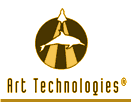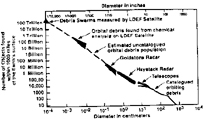COLLISION: An Interdisciplinary Approach to Orbital Debris
Richard Clar and Mark Mantel Ph.D.
Art Technologies
Beverly Hills, California
Abstract
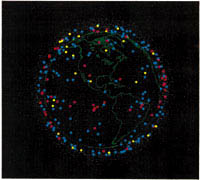
The integration of science and the arts can take many forms. In this collaboration, a "site-specific" interdisciplinary artwork and performance will be created by using known data from orbiting space debris around Earth to generate musical and visual information through a shared computer program. We will then create aural and visual models-including a constellation sculpture-of this transformed data.
Background
The recent years have been years of great concern for our environment. As the exploration and conquest of space and space technologies grow, so does concern with spent Earth-orbiting material. The overpopulation of space debris in low-Earth orbit is now a very real danger to space exploration.
In this paper, it is possible to present only a brief overview of the orbital debris problem. A wealth of material on this subject exists for those interested in more detailed studies. The Aerospace Database has 1,545 articles on orbital debris from 1976 to the present. A 1993 NASA publication entitled Orbital Debris and Near-Earth Environmental Management: A Chronology1 by David S.F. Portree and Joseph P. Loftus, Jr., provides a background briefing on the 32-year history of the subject.
Starting in 1957, there have been more than 3,400 space launches by different nations into Earth orbit.2 Led by Russia and the United States, an undesired result of these launches over the years has been the creation of a large orbital debris population. Orbital debris consists of spent rocket bodies, non-functioning satellites, space hardware, paint chips, and various sizes of fragments from explosions and collisions. The total mass of debris in orbit is now approximately 3,000,000 kg at altitudes below 2000 km.3 The concentration of orbital debris in Low-Earth orbit varies as seen in Fig. 1:
Fig. 1. The Number of Objects in Low-Earth Orbit as Estimated from Various Measurements.
(Chart: NASA, Johnson Space Center).
The precise number of human-made objects in space is unknown. The present (1993) NORAD/USSPACECOM catalog lists about 7200 objects. Use of detection methods more sensitive than those employed to create the catalog has produced dramatically higher estimates of the number of objects in Earth orbit. The smallest objects (paint chips, splinters of glass, and aluminum particles sprayed out by solid rocket motors) likely number 100 trillion. This chart is based on measurements which sample the environment and shows estimates of the number of objects in orbit of a given size and larger.
The United States Space Command (USSPACECOM) tracks and catalogs over 7,900 objects in orbit. These objects range in size down to 10 cm in Low-Earth Orbit (LEO) and down to 1m in higher orbits.
The information in the USSPACECOM catalog is updated regularly and is published by NASA as the Satellite Situation Report (SSR).4
There have been over 100 explosions in space creating orbital debris clouds that further increased the orbital debris density. As the density of the orbital debris increases so do the chances of collision with a spacecraft or other orbital debris. Scientists have suggested that a "critical density" of orbital debris may be reached that eventually triggers a catastrophic chain reaction of collisions. This chain reaction once begun, would continue over a period of time destroying all objects in near-Earth orbit.
Since the Shuttle program began in 1981, more than 25 windows have had to be replaced due to damage by hypervelocity impacts of orbital debris. Each window replacement costs over U. S. $50,000.5
Given the current budget restraints of most of the space-faring nations, the most viable and cost effective option to the orbital debris problem is the careful management of future space missions to minimize the impact on the Earth orbits.
No binding agreements have been reached on how to mitigate and minimize orbital debris in spite of all the papers, articles, newsletters, and books written on this topic.6 The problem of orbital debris must be addressed through international agreements by all space-faring nations in order to ensure a safe space environment for our future generations.
Art
As artists, our interdisciplinary "site-specific" work COLLISION will focus more attention on the issue of orbital debris and emphasize our deep concern for progress and careful management of our near-Earth environment.
Art exists on many different levels, not all of which are visible to humans unaided. In the creative act, the artist and the scientist may share the same tools to reveal what once existed only in the imagination.
"Art does not reproduce the visible; rather it makes visible." These words by Paul Klee, the Swiss abstract painter, are the opening to his Creative Credo written in 1918 and first published in 1920.7 Using the tools of science-the microscope, the telescope, and the super-computer-will enable us to "see" COLLISION.
Throughout history, the "found object" has been used by various cultures in the creation of their art. During this century, the "found object" figures significantly in a number of great artists' work. Duchamp, Man Ray and Picasso-to name a few-all utilized the found object. An excellent example is Picasso's "Bull with Horns" (Fig. 2). The genius of Picasso is revealed once again in "Bull with Horns" where a used and discarded old bicycle seat and handle bars are combined to form an exquisitely simple sculpture of a bull's head with horns. The objects by themselves, the bicycle seat and handlebars, are nothing more than junk-certainly not considered to be art. Yet when Picasso-in the creative act of selection-combined them, the objects were transformed and a new meaning for them was created. An analogy may be made for COLLISION and the use of orbital debris to create a highly significant work of art.
A small school of artists exists today that is interested in creating artworks that orbit in space.8 Often, the concepts of these artists are limited by factors such as cost and feasibility. Objections to artworks in outer space have been raised by astronomers fearing light contamination and interference in the sky by orbiting artworks. Concerns for anything considered unnecessary and adding to the existing orbital debris population have been voiced by other scientists as well (although that is a subject certainly open to debate).
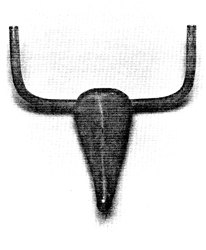
Fig. 2. Pablo Picasso. Bulls Head. 1943
Height 41 cm.
Musée Picasso, Paris
PHOTO R.M.N.-SPADEM
COLLISION will achieve the goal of creating an orbiting constellation sculpture (Fig. 3) in space without any of the aforementioned negative effects, since no additional material needs to be orbited in order to produce the desired results. By utilizing orbital debris that is already in orbit to create art, the problem becomes part of the solution; the concerns of the scientific community are heeded; and the public's consciousness is raised concerning the orbital debris problem.
The production of COLLISION will result in the introduction of the critical issue of orbital debris to a far broader and more diverse audience, and will represent the high technology and significant art for which the United States is known. COLLISION will extend the parameters of Earth-bound art creating a new paradigm based on the unlimited expanse of outer space.
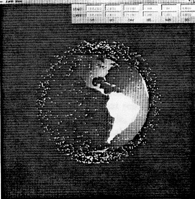
Fig. 3. COLLISION, orbiting
constellation sculpture, 1995.
Computer simulation:
The Aerospace Corporation
Description of Project
Orbital debris or "space junk" presents an opportunity to create an interdisciplinary artwork of "found" objects from the over 7,900 pieces of tracked orbital debris now surrounding our planet. NASA Satellite Situation Reports are used to track orbital debris on a daily basis. Using the complex data on this debris, an exciting large-scale work that encompasses music and visuals will be created. Since this information provided by NASA is calculated to project the future position of the debris on a day-to-day basis, one can create a work which, in an aural/visual sense, recreates the position of this orbital debris on a specific date/time; hence the notion of a "site-specific" work.
Only a short time ago-before the existence of massively parallel computing capabilities-it was not possible to do a visual simulation of a concept such as COLLISION. Due to the amount of calculations involved, the concept would remain only in the mind of the artist. Advances in super-computing leading to computers like the massively parallel Connection Machine CM5-E, running a program called CM-COMBO9 (Calculation Of Miss Distance Between Objects) makes an artwork like COLLISION possible.
By utilizing the same data through a shared computer program at a critical construction phase in the work, a sense of unity and coherence is established while still allowing for a wide range of artistic transformation idiosyncratic to each discipline.
For the performance of COLLISION, items such as the number of objects; the country to which they belong; catalog number; period; inclination; apogee; and perigee, will be used to determine specific parameters. These parameters include instrumental groups/choices, timbre, color field, tempo, pitch/frequency, and spatial placement of visual images.
The work is envisioned for a live instrumental group, real-time digital processing, and live interactive video walls. While the instrumental group remains essentially an acoustic group of musicians, all of the players will be amplified. Their signals are sent to digital enhancers, delays, and processors which extend the acoustical realities of each instrument.
Visual images used for the COLLISION performance will span the scale from micro, such as the LDEF10 micrographs of hypervelocity impacts, to macro, including a kinetic visual model of the orbital debris constellation sculpture encompassing the entire Earth. Designating certain orbital debris objects with specific values, a massively parallel high-performance computer will convert the two-line element sets from the NASA Satellite Situation Reports to create a visual model of a site-specific artwork on a previously unheard-of scale.
Music
Since the invention of the computer and the first musical synthesizer in the 1950's, a very technical kind of composing, a music that devoted itself to the transformation of numbers (or data) into sound, has played a critical role in the development of modern concert music and electronic music, and has even shaped the evolution of electronic instruments. The interest in "plugging in" numbers-numbers that represented specific frequencies, amplitude, duration, etc.-have occupied the musical world in many cultures. In fact, in the early part of the century a movement referred to as "serial music," or a specific order of pitches whose numerical position in a sequence was manipulated, became increasingly more popular with composers. As we progressed through the mid-century these manipulations often relied on increasingly complex mathematical patterns. When combined with the explosion of the music synthesizer, a kind of music generally referred to as electronic music and/or computer music evolved.
As noted in the DESCRIPTION OF PROJECT, analogs will be created between the musical composition and the video composition of COLLISION through shared data and processing. The interest in sharing the exact data lies in the unlimited possibilities that the application of this data holds in both the aural and visual worlds. Decisions regarding specific parameters (linear movement for example) will serve as the point of departure in the visual and musical components of COLLISION. Also, decisions pertaining to those components of the Satellite Situation Reports (SSR) to be used will be shared. The numerical data from the SSRs can influence specific idiomatic instrumental functions, or it can determine pitch, timbre, attack and decay envelopes. An example can be seen related to pitch. The human ear is suited for hearing a range of 20 Hz through 20,000 Hz. A number, such as the inclination of a satellite might be 108.1 degrees, a musical frequency that is a high B natural (108.1 translated as 1081 Hz). It becomes possible to have a numerical parameter from the SSRs translate into musical durations, such as quarter-notes or thirty-second notes. It is also possible that a certain parameter (apogee and perigee, for instance) might yield long and slow-moving rhythmic patterns while others will create more abrupt and disturbing rhythmic patterns. It is easy to envision COLLISION moving between many levels of rhythmic interplay, obscured by nonrecurring, singular musical events.
In the world of the interdisciplinary, or interactive musical realms, this "number-crunching" kind of composition takes on an exciting flavor and avoids the kind of rigidity that has too often become the hallmark of purely electronic music. COLLISION is scored for live instrumentalists because the sounds of the acoustic instruments, as well as the presence of live musicians and the nuance that only humans are able to execute, will work best in the presentation we envision. These instruments are subject to digital signal processing during the live performance to enhance the aural and visual experience.
The music for COLLISION is scored for:
2 flutes, each doubling alto flute
2 oboes, each doubling English horn
2 clarinets, each doubling bass clarinet
Electric guitar, with effects
Percussion (yet to be
determined)
Piano plus electronic keyboard
In addition:
Stereo sound reinforcement
Live Digital Signal Processing
As referenced above, some data from the SSRs will influence decisions about frequency (pitch as expressed in Hz), and instrumental selection. In this case, the range of each instrument plays an important part, as not all frequencies (pitch) are available on every instrument. Here, an interesting situation is created where orchestration (the selection and use of instruments) will be determined at times by the limitations of the ensemble. Similarly, these strings of numbers can be transformed (with absolute rigidity, or complete spontaneity) into many levels of the musical fabric of COLLISION. The significance of this compositional method lies in the sharing of this numerical data with the visual aspect of the work. We use this data to inform compositional and creative decision-making in the work. Ultimately, we will assemble the aural and visual and refine them into the performance piece COLLISION.
It is possible that in the event of a series of performances, each previous performance can be incorporated into the succeeding performance via tape playback. Each performance is a metaphysical attempt to reflect the specific correlation and position of orbiting space debris on that date. The final performance would project the feeling of a "sensory overload" reflecting the concern for the amount of orbital debris circling our endangered planet.
Audience Appeal
The collaboration of the various disciplines (as exemplified by COLLISION) is not new. Opera represents a beginning point for the first serious attempt of inter-media presentations, combining music and drama.11 However, it is cited for another, more critical reason. Late 18th Century and certainly most of the 20th Century operas had thinly veiled, and more often blatantly overt political implications. In a similar vein, COLLISION delivers an alert to the potential hazards of orbital debris. COLLISION sets out to recognize the fundamental need for exploration, and comments on the methods that have been used in the past. As a global community, we have been less then careful concerning the ecological impact of space exploration. We must be as concerned with the careful management of our atmosphere as we are concerned with our Earthbound environment. Our position here is very clear: the arts should indeed support the exploratory ventures that our colleagues in the sciences envision, and that exploration must be done with the least amount of waste and risk possible.
To that end, a serious and ambitious production of COLLISION has the opportunity to reach a broader audience, most notably the arts public and the mass media in general. COLLISION can demonstrate that space technologies are our allies, and that great beauty can come from the constant exploration of our near-Earth environment.
We feel COLLISION will be met with great interest and enthusiasm in the art and scientific community at large. 1992 was designated the "International Space Year" (ISY).12 The celebration of ISY highlighted the themes of both Exploration and Discovery. Benefits of ISY included increased awareness and appreciation of space activities at both the scientific and public levels. COLLISION is being created in the ongoing spirit of ISY that extends well beyond 1992. The concepts expressed in this multidimensional approach to the hazards of orbital debris are both intriguing and compelling. The exploration and ultimate taming of our near-Earth environment serve as a metaphor for exploration of all types, inward as well outward.
Artistic creativity and high technology combined and used to address an issue of great concern to the world space community, will enlighten and stimulate its audiences.
References & Notes
1. David S.F. Portree and Joseph P. Loftus, Jr., Orbital Debris and Near-Earth Environmental Management: A Chronology (Houston, TX: NASA-RP-1320 1993).
2. Position Paper on Orbital Debris, compiled by an Ad hoc Expert Group of the International Academy of Astronautics Committee on Safety, Rescue, and Quality. March 8, 1993. p. 1.
3. Donald J. Kessler, Robert C. Reynolds and Phillip D. Anz-Meador, Orbital Debris Environment for Spacecraft Designed to Operate in Low Earth Orbit (Houston, TX: NASA-TM-100471 1988) p.1.
4. Satellite Situation Report (Greenbelt, MD, Goddard Space Flight Center).
5. See Portree and Loftus [1] p.85.
6. See Position Paper on Orbital Debris [2] p.16.
7. For an English translation of the "Creative Credo," see Victor Miesel, ed., Voices of German Expressionism (Englewood Cliffs, NJ: Prentice-Hall, 1970), pp. 83-88.
8. Roger F. Malina, "Space Art: The Role of the Artist in Space Exploration" (Paris: International Astronautical Federation, 1989). This paper was presented at the 40th Congress of the International Astronautical Federation, 7-12 October 1989, Malaga, Spain.
9. CM-COMBO (Calculation of Miss Distance Between Objects), Developed by the Naval Center for Space Technology at the Naval Research Laboratory, Washington, D.C.
10. Long Duration Exposure Facility (LDEF) micrographs were done by The Aerospace Corporation, Los Angeles , CA.
11. Donald Jay Grout, A History of Western Music, 3rd ed., with Claude Palisca (New York, NY: W.W. Norton & Co., 1980) chapters XVII and XIX.
12. INTERNATIONAL SPACE YEAR Twenty-eight space agencies participated, including those of all the major space powers. The United States, Russia, France, Japan, Germany, and England, joined together to form SAFISY (Space Agency Forum on International Space Year). This coalition formed ISY planning committees to develop themes and general plans for a global celebration and other activities that extend into the next five years.
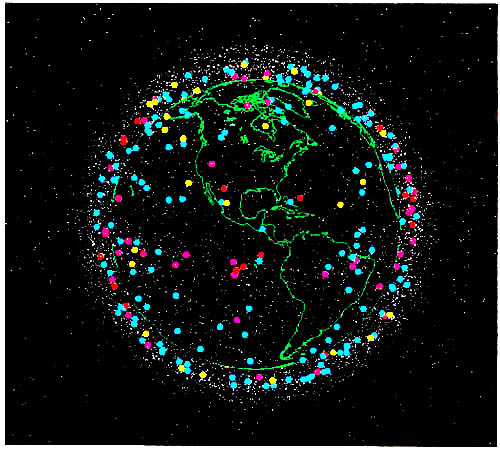
Image credit: The Naval Research Laboratory
